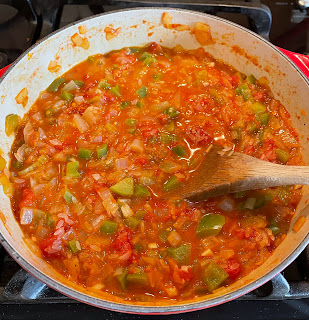This past week certainly has felt anything but celebratory, but here we are at Mardi Gras with Lent beginning tomorrow. While I'm not really one to get into the idea of getting all of one's indulgences in before a season of self-denial, I do enjoy good New Orleans food regardless of the season. Mardi Gras gives occasion to be intentional with foods that have taken on a distinctive North American style. Whether or not your denomination formally observes Lent, this year's season leading up to Easter seems a particularly appropriate time for humility, self-reflection, repentance, and praying for the welfare of others. I will share links to some resources at the close of this post.
For now, let's learn a little about the history of jambalaya. Like many New Orleans-style dishes, jambalaya represents a blending of French, African, and Spanish influences. In its simplest sense, jambalaya is meat and vegetables cooked together with rice. A recipe for jambalaya first appeared in spring in 1878 when it appeared in the Gulf City Cook Book published by the ladies of the St. Francis Street Methodist Episcopal Church in South Mobile, Alabama. Given its simplicity and flexibility, jambalaya had a brief surge in popularity during the 1920s and 1930s.
Jambalaya typically includes the Creole trinity of onions, celery, and bell peppers; rice; tomatoes; and meat. The meat can vary but is typically chicken, sausage, and shrimp in any combination or singly.
When making jambalaya from scratch, rather than from a Zatarain's mix (which is still pretty good), I've had the best luck using parboiled rice. Parboiled rice is also known as converted rice and refers to rice that has been partially boiled while still in its husk. Parboiling preserves some of the micronutrients in the rice. Most important for jambalaya, parboiled rice is firmer and holds its shape. I also tend to use parboiled rice in soups when I need the rice to hold its shape over time.
Here's how we prepared our jambalaya:
- 1 lb boneless, skinless chicken breasts (Note: You can use bone-in chicken, too you will just need to do the work of removing the meat from the bones. We have also used smoked turkey that we had on hand. If the poultry has already been cooked, you will just need to use prepared broth.)
- Cooking oil
- 1/2 lb smoked sausage, cut into rounds (We use 2 links of Aidells cajun style andouille)
- 2 cups chopped onion
- 1/2 cup chopped bell pepper - feel free to use a little more if you like
- 1/2 cup chopped celery
- 2 tsp minced garlic
- 1 quart jar of home canned tomatoes (We use the entire jar - juice and all. You could substitute a 30-ounce can.)
- 1/2 tsp white pepper
- 1/2 tsp black pepper
- 1/4 tsp cayenne pepper
- 1 tsp salt (if using prepared broth, you may need less)
- 1 1/2 cups parboiled rice
- 1 1/2 cups chicken stock (from cooking the chicken)
- This site provides devotions based on Psalms
- This site will release daily devotions through the Lent season
- Luther Seminary has a downloadable devotional for 2022





